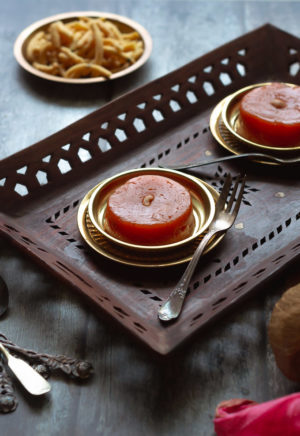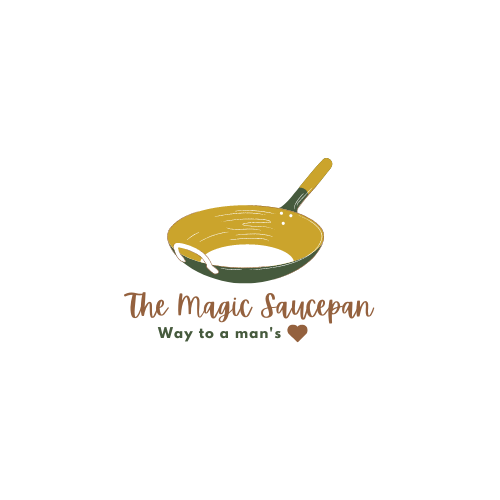Ashoka Halwa - Traditional South Indian dessert from the thiruvaiyaru region in Tamil Nadu. A melt in the mouth delicacy made with mung dal, sugar and ghee. A rich dessert that is not for the faint of heart.

History & Origin of Ashoka Halwa
This is known as asoka or asoka sweet by the locals. Ashoka is not an actual halwa and is generally considered a sweet.
There is no concrete evidence as to who created this and especially why this is called asoka halwa. Asoka halwa originated in Thiruvaiyaru, a small town in South India and it is said to have created by one of the residents Mr. Ramu Iyer. Halwa made of wheat is quite common in Tamil Nadu and infect it was the only halwa that existed here until globalization picked up pace. Ashoka halwa was born out of necessity and need. During world war II wheat was scarce and people were looking for alternatives to create sweets with. Mung dal came to the rescue and this awesome delicacy was created as an alternative to halwa .
Asoka sweet is a must during Tamil Iyer weddings, especially for those from the delta region in Tamil Nadu. This is not commonly available in sweet shops and is mostly prepared at home during special occasions. If you are visiting thiruvaiyaru, the birthplace of ashoka, then do not forget to stop by andavar halwa shop to get the most authentic and delicious asoka. They only sell asoka sweet and wheat halwa.
Did you know that Asoka Halwa is not an actual halwa variety ? It is known as just Asoka or Asoka sweet.

Asoka Halwa - traditional thiruvaiyaru halwa made with mung dal, sugar and ghee. 
Asoka Halwa
Tips to remember - Asoka Halwa
- Dry roast the mung dal until you get a nice aroma. Do not fry it in ghee or any other fat. The flavor changes and while frying in ghee it is difficult to smell the aroma of the dal which decides how long you should roast the dal.
- The final consistency of the halwa is very smooth. Hence it is necessary to cook the dal until it is mushy and grind the cooked dal to get that even texture.
- The ratio of the amount of ghee used - Well, I said in my intro that this sweet is not for the faint of heart. You can certainly reduce the amount of ghee but there is a minimum quantity that should be used to get the flavour.
FAQ
Yes, adding wheat flour is optional. Wheat flour acts as a binding agent and gives the asoka halwa a smooth finish.
Yes, you will get a pale brown colored halwa. Though the speciality of asoka is its red colour we certainly cannot compromise our health. Either skip the food colour completely or go for natural coloring agents that are vegetable based.
If you are visiting thiruvaiyaru, stop by andavar halwa shop to get the most authentic and delicious asoka.
You can certainly reduce the amount of ghee as per your health or personal preferences. But I strongly recommend you not to skip the amount of ghee mentioned below for the this recipe. This is a special occasion treat and can be enjoyed in minimum quantities occasionally.

I always thought that good tasty things are hard and complicated to make. But when I found that my most beloved sweet is quite easy I was so elated. It uses three main ingredients and unlike the other halwa's, it is not time or labour consuming. Of course some work is required but it is manageable even for the novice cook. I would also like to point out that this is not for the fitness freaks out there. It has a huge amount of fat (ghee) that imparts the silky shiny texture and makes it to melt in the mouth as soon as you take a spoon.
The highlight of the sweet is its red hue and the shiny glossy finish.


- 1 cup mung dal - pasi parupu
- 1.5 to 2 cups sugar
- ¾ cup ghee, divided
- ¼ cup wheat flour
- ¼ teaspoon cardamom powder
- 2 tablespoon cashews broken and roasted in ghee
- A pinch of red food colour mix it in a tablespoon water
-
Roasting the mung dal: Dry roast the mung dal until it starts emiting aroma and a slight change in colour occur. (refer note 1)
-
Cook and grind the mung dal: Pressure cook the dal until it is smashed and mushy. Keep for about 7-8 whistles in a Indian style pressure cooker.
Once the pressure is released, transfer the cooked dal to a blender. While it is still warm, blend the dal mixture in a blender/mixie. Set aside. Keep it closed so that it does not become dry. (refer note 2)
-
Making Asoka Halwa: Heat a heavy bottomed pan, add 4 tablespoon ghee and roast the wheat flour until it becomes golden brown. Do not burn it. Keep it in low medium flame and roast until it bubbles well and slightly becomes golden brown. The entire wheat mixture should be mixed well in ghee.
-
Immediately transfer the cooked dal and add sugar to it. Stir frequently. As the mixture thickens, start adding ghee in batches, a tablespoon at a time.
-
Keep stirring until the mixture starts leaving the sides of the pan and the whole mixture amass.
-
It will take about 12 -15 minutes. Turn off the flame. To check if asoka halwa is done, rub it between your fingers and it should not be sticky.
-
Finally add the powdered cardamom, cashews and food colour (mixed in water) mixture. Mix it well and switch off the flame.
- Dry roast the mung dal until you get a nice aroma. Do not fry it in ghee or any other fat. The flavor changes and while frying in ghee it is difficult to smell the aroma of the dal which decides how long you should roast the dal.
- The final consistency of the halwa is very smooth. Hence it is necessary to cook the dal until it is mushy and grind the cooked dal to get that even texture.
- Be careful while blending the hot/warm mixture. It is advised to blend the dal while it is still warm to blend it evenly.
- The ratio of the amount of ghee used - Well, I said in my intro that this sweet is not for the faint of heart. You can certainly reduce the amount of ghee but there is a minimum quantity that should be used to get the flavour.
Update: Old post updated with new pics.






Ruchi Indu says
romba nanna irukku 🙂 the clicks are very tempting.. Very intelligently you transformed a dish starting with A to a dish starting with H
veena krishnakumar says
I didn't know that it was Thiruvaiyaru special. Looks very tempting Nisha
Chef Mireille says
what a luxurious texture
Smruti Shah says
Awesome clicks of an absolutely lovely Halwa. The gloss is perfect and the plate looks wholesome. Great Nisha!!
Priya Suresh says
Such a glossy and prefect looking shiny halwa, stunning clicks Nisha.
Srividhya Gopalakrishnan says
Delicious halwa.. stunning clicks
The Pumpkin Farm says
sinful...and i like the absence of light in your pictures...u r very good with the camera
Padma Rekha says
this is in my to do list never no moong dall is added to this interesting bookmarked.. BTW your pictures are just awesome..
Harini-Jaya R says
Lovely clicks and mouth watering halwa. Never imagined Asoka halwa is made out of moong dal.
vaishali sabnani says
What a stunning halwa..love the clicks as well..absolutely new one for me, very very interesting recipe as well.
Gayathri Kumar says
That is one awesome plate of halwa. Looks absolutely divine...
Sandhya Ramakrishnan says
Asoka halwa is my favorite in weddings and I had it put up in the menu for my parents 60th birthday. We had cooks cooking in our village home and I stood beside the cook the whole time when he was making it. Got the recipe from him and that is when I made mine for the first time;. Yours looks so luscious. I am tempted to eat some now 🙂
Sapana Behl says
The halwa looks so rich and decadent .Love your lightening and props.I guess you have found your perfect spot in the house.
Suma Gandlur says
Moongdal halwa is one of the decadent ones among the halwa categories and love it. Addition of wheat flour to this one is new to me. I had wrobgly assumed that asoka halwa is the one that is made with wheat milk.
rajani says
We used to buy Tirunelveli halwa and finish it off so fast! Somehow that's the first thing that came to my mind when I saw the picture.
Pavani N says
That is a perfectly made halwa Nisha. Looks so delicious.
Srivalli says
I love this halwa and when I made it, it was with maida..very lovely colour..did you mean pasiparuppu by Mung Dahl?..
Amara Annapaneni says
Halwa looks delicious Nisha, I never tasted it but heard a lot about it. Thanks for the amazing recipe, bookmarked:)
Usha Rao says
Never tasted Ashoka halwa. You wanting it on all the days of you wedding ceremonies speaks volumes about the taste and how much you like it.